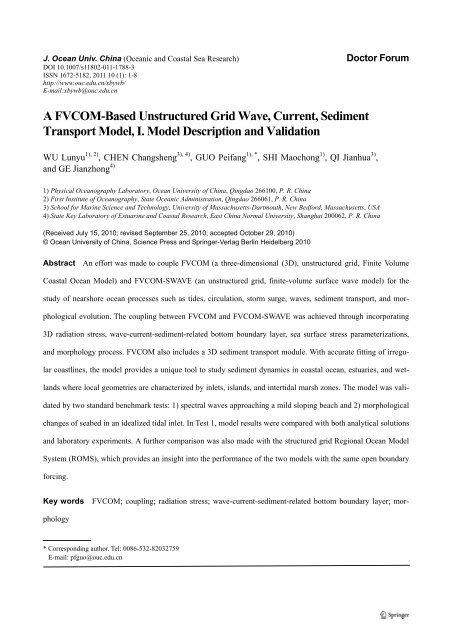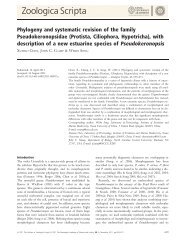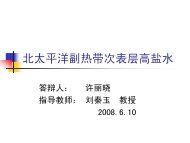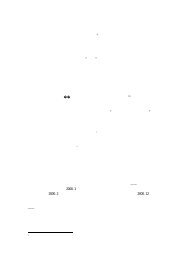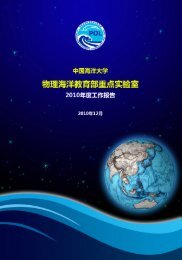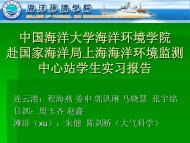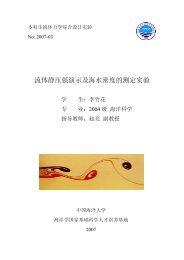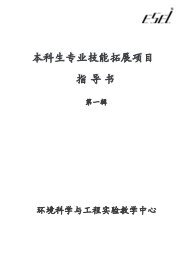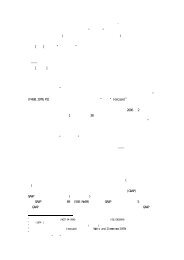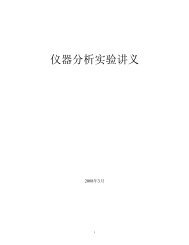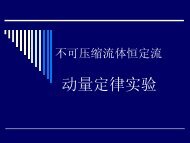A FVCOM-based unstructured grid wave-current-sediment model
A FVCOM-based unstructured grid wave-current-sediment model
A FVCOM-based unstructured grid wave-current-sediment model
Create successful ePaper yourself
Turn your PDF publications into a flip-book with our unique Google optimized e-Paper software.
J. Ocean Univ. China (Oceanic and Coastal Sea Research) Doctor ForumDOI 10.1007/s11802-011-1788-3ISSN 1672-5182, 2011 10 (1): 1-8http://www.ouc.edu.cn/xbywb/E-mail:xbywb@ouc.edu.cnA <strong>FVCOM</strong>-Based Unstructured Grid Wave, Current, SedimentTransport Model, I. Model Description and ValidationWU Lunyu 1), 2) , CHEN Changsheng 3), 4) , GUO Peifang 1), * , SHI Maochong 1) , QI Jianhua 3) ,and GE Jianzhong 4)1) Physical Oceanography Laboratory, Ocean University of China, Qingdao 266100, P. R. China2) First Institute of Oceanography, State Oceanic Administration, Qingdao 266061, P. R. China3) School for Marine Science and Technology, University of Massachusetts-Dartmouth, New Bedford, Massachusetts, USA4) State Key Laboratory of Estuarine and Coastal Research, East China Normal University, Shanghai 200062, P. R. China(Received July 15, 2010; revised September 25, 2010; accepted October 29, 2010)© Ocean University of China, Science Press and Springer-Verlag Berlin Heidelberg 2010Abstract An effort was made to couple <strong>FVCOM</strong> (a three-dimensional (3D), <strong>unstructured</strong> <strong>grid</strong>, Finite VolumeCoastal Ocean Model) and <strong>FVCOM</strong>-SWAVE (an <strong>unstructured</strong> <strong>grid</strong>, finite-volume surface <strong>wave</strong> <strong>model</strong>) for thestudy of nearshore ocean processes such as tides, circulation, storm surge, <strong>wave</strong>s, <strong>sediment</strong> transport, and morphologicalevolution. The coupling between <strong>FVCOM</strong> and <strong>FVCOM</strong>-SWAVE was achieved through incorporating3D radiation stress, <strong>wave</strong>-<strong>current</strong>-<strong>sediment</strong>-related bottom boundary layer, sea surface stress parameterizations,and morphology process. <strong>FVCOM</strong> also includes a 3D <strong>sediment</strong> transport module. With accurate fitting of irregularcoastlines, the <strong>model</strong> provides a unique tool to study <strong>sediment</strong> dynamics in coastal ocean, estuaries, and wetlandswhere local geometries are characterized by inlets, islands, and intertidal marsh zones. The <strong>model</strong> was validatedby two standard benchmark tests: 1) spectral <strong>wave</strong>s approaching a mild sloping beach and 2) morphologicalchanges of seabed in an idealized tidal inlet. In Test 1, <strong>model</strong> results were compared with both analytical solutionsand laboratory experiments. A further comparison was also made with the structured <strong>grid</strong> Regional Ocean ModelSystem (ROMS), which provides an insight into the performance of the two <strong>model</strong>s with the same open boundaryforcing.Key words <strong>FVCOM</strong>; coupling; radiation stress; <strong>wave</strong>-<strong>current</strong>-<strong>sediment</strong>-related bottom boundary layer; morphology* Corresponding author. Tel: 0086-532-82032759E-mail: pfguo@ouc.edu.cn
WU et al. / J. Ocean Univ. China (Oceanic and Coastal Sea Research) 2011 10 (1): 1-8ReferencesBijker, E. W., Kalwijk, J. P. Th., and Pieters, T., 1974. Mass transport in gravity <strong>wave</strong>s on a sloping bottom. Proc.14th Conf. Coastal Engineering, vol. 2. ASCE, New York, 447- 465.Booij, N., Haagsma, I. J. G., Holthuijsen, L. H., Kieftenburg, A. T. M. M., Ris, R. C., van der Westhuysen, A. J.,and Zijlema, M., 2004. SWAN Cycle III version 40.51 User Manual. Delft University of Technology, Available:http://fluidmechanics. tudelft.nl/swan/index.htm.Burchard, H., 2002. Applied Turbulence Modeling in Marine Waters. Lecture Notes in Earth Sciences, Springer:Berlin- Heidelberg-New York-Barcelona-Hong Kong-London-Milan Paris-Tokyo, 215pp.Chen, C. S., Liu, H. D., and Beardsley, R. C., 2003. An <strong>unstructured</strong> <strong>grid</strong>, finite-volume, three-dimensional,primitive equation ocean <strong>model</strong>: application to coastal ocean and estuaries. Journal of Atmospheric and OceanicTechnology, 20: 159- 186.Chen, C. S., Beardsley, R. C., and Cowles, G., 2006a. An <strong>unstructured</strong> <strong>grid</strong>, finite-volume coastal ocean<strong>model</strong>–<strong>FVCOM</strong> user manual, School for Marine Science and Technology, University of Massachusetts Dartmouth,New Bedford, Second Edition. Technical Report SMAST/UMASSD-06-0602, 318pp.Chen, C. S., Beardsley, R. C., and Cowles, G., 2006b. An <strong>unstructured</strong> <strong>grid</strong>, finite-volume coastal ocean <strong>model</strong>(<strong>FVCOM</strong>) system. Special Issue: Advance in Computational Oceanography, Oceanography, 19 (1): 78-89.Chen, C. S., Huang, H. S., Beardsley, R. C., Liu, H. D., Xu, Q. C., and Cowles, G., 2007. A finite-volume numericalapproach for coastal ocean circulation studies: comparisons with finite difference <strong>model</strong>s. Journal ofGeophysical Research, 112, C03018. DOI: 10.1029/2006JC003485.Donelan, M. A., Dobson, F. W., and Smith, S. D., 1993. On the dependence of sea surface roughness on <strong>wave</strong>development. Journal of Physical Oceanography, 23: 2143-2149.Grant, W. D., and Madsen, O. S., 1979. Combined <strong>wave</strong> and <strong>current</strong> interaction with a rough bottom. Journal ofGeophysical Research, 84 (C4): 1797-1808.Haidvogel, D. B., Arango, H., Budgell, W. P., Cornuelle, B. D., Curchitser, E., Di Lorenzo, E., Fennel, K., Geyer,W. R., Hermann, A. J., Lanerolle, L., Levin, J., McWilliams, J. C., Miller, A. J., Moore, A. M., Powell, T. M.,Shchepetkin, A. F., Sherwood, C. R., Signell, R. P., Warner, J. C., and Wilkin, J., 2008. Ocean forecasting interrain-following coordinates: Formulation and skill assessment of the Regional Ocean Modeling System.Journal of Computational Physics, 227: 3595-3624.Huang, H. S., Chen, C. S., Cowles, G. W., Winant, C. D., Beardsley, R. C., Hedstrom, K. S., and Haidvogel, D. B.,2008. <strong>FVCOM</strong> validation experiments: comparisons with ROMS for three idealized barotropic test problems.Journal of Physical Oceanography, 113, C07042. DOI: 10.1029/ 2007JC004557.Lai, Z. G., Chen, C. S., Cowles, G., and Beardsley, R. C., 2010a. A non-hydrostatic version of <strong>FVCOM</strong>, Part I:validation experiment. Journal of Geophysical Research, 115. DOI: 10.1029/2009JC005525.Lai, Z. G., Chen, C. S., Cowles, G., and Beardsley, R. C., 2010b. A non-hydrostatic version of <strong>FVCOM</strong>, Part II:mechanistic study of tidally generated nonlinear internal <strong>wave</strong>s in Massachusetts Bay. Journal of GeophysicalResearch. DOI: 10.1029/2010JC006331.Liang, B. C., Li, H. J., and Lee, D. Y., 2007. Numerical study of three-dimensional suspended <strong>sediment</strong> transport
WU et al. / J. Ocean Univ. China (Oceanic and Coastal Sea Research) 2011 10 (1): 1-8in <strong>wave</strong>s and <strong>current</strong>s. Ocean Engineering, 34: 1569-1583.Liu, H. Q., and Xie, L. A., 2009. A numerical study on the effects of <strong>wave</strong>-<strong>current</strong>-surge interactions on the heightand propagation of sea surface <strong>wave</strong>s in Charleston Harbor during Hurricane Hugo 1989. Continental ShelfResearch, 29: 1454- 1463.Longuet-Higgins, M. S., and Stewart, R. W., 1960. Changes in the form of short gravity <strong>wave</strong>s on long <strong>wave</strong>s andtidal <strong>current</strong>s. Journal of Fluid Mechanics, 8: 565-583.Longuet-Higgins, M. S., and Stewart, R. W., 1964. Radiation stress in water <strong>wave</strong>s: a physical discussion withapplications. Deep Sea Research, 11: 529-562.Longuet-Higgins, M. S., 1970a. Longshore <strong>current</strong>s generated by obliquely incident sea <strong>wave</strong>s, 1. Journal of GeophysicalResearch, 75 (33): 6778-6789.Longuet-Higgins, M. S., 1970b. Longshore <strong>current</strong>s generated by obliquely incident sea <strong>wave</strong>s, 2. Journal ofGeophysical Research, 75 (33): 6790-6801.Mellor, G. L., and Yamada, T., 1982. Development of a turbulence closure <strong>model</strong> for geophysical fluid problem.Reviews of Geophysics and Space Physics, 20: 851-875.Mellor, G. L., 2003. The three-dimensional <strong>current</strong> and surface <strong>wave</strong> equations. Journal of Physical Oceanography,33: 1978-1989.Mellor, G. L., 2005. Some consequences of the three- dimensional <strong>current</strong>s and surface <strong>wave</strong> equations. Journalof Physical Oceanography, 35: 2291-2298.Mellor, G. L., 2008. The Depth-Dependent Current and Wave Interaction Equations: A Revision. Journal ofPhysical Oceanography, 38: 2587-2596.Moon, I. J., 2005. Impact of a coupled ocean <strong>wave</strong>-tide- circulation system on coastal <strong>model</strong>ing. Ocean Modelling,8: 203- 236.Qi, J. H., Chen, C. S., and Beardsley, R. C., 2009. An <strong>unstructured</strong>-<strong>grid</strong> finite-volume surface <strong>wave</strong> <strong>model</strong>(<strong>FVCOM</strong>- SWAVE): Implementation, validations and applications. Ocean Modelling, 28: 153-166.Roelvink, J. A., 2006. Coastal morphodynamic evolution techniques. Coastal Engineering, 53: 277-287.Sørensen Ole, R., Henrik Kofoed-Hansen and Jones Oliver P. 2006. Numerical <strong>model</strong>ing of <strong>wave</strong>-<strong>current</strong> interactionin tidal areas using an <strong>unstructured</strong> finite volume technique. Proceedings of the 30th International Conferenceof Coastal Engineering 2006, San Diego, California, USA. 1: 653-665.Tang, H. S., Keenb, T. R., and Khanbilvardi, R., 2009. A <strong>model</strong>- coupling framework for nearshore <strong>wave</strong>s, <strong>current</strong>s,<strong>sediment</strong> transport, and seabed morphology. Communications in Nonlinear Science and Numerical Simulation,14 (7): 2935- 2947.Tolman, H. L., 1990. The influence of unsteady, depths and <strong>current</strong>s of tides on wind-<strong>wave</strong> propagation in shelfseas. Journal of Physical Oceanography, 20: 1166-1174.Warner, J. C., Sherwood, C. R., Signell, R. P., Harris, C., and Arango, H. G., 2008. Development of athree-dimensional, regional, coupled <strong>wave</strong>, <strong>current</strong>, and <strong>sediment</strong>-transport <strong>model</strong>. Computers and Geosciences,34: 1284-1306.Xia, H. Y., Xia, Z. W., and Zhu, L. S., 2004. Vertical variation in radiation stress and <strong>wave</strong>-induced <strong>current</strong>.Coastal Engineering, 51: 309-321.Xie, L. A., Wu, K. J., and Pietrafesa, L., and Zhang, C., 2001. A numerical study of <strong>wave</strong>–<strong>current</strong> interactionthrough surface and bottom stresses: Wind-driven circulation in the South Atlantic Bight under uniform winds.
WU et al. / J. Ocean Univ. China (Oceanic and Coastal Sea Research) 2011 10 (1): 1-8Journal of Geophysical Research, 106 (C8): 16 841-16 855.


